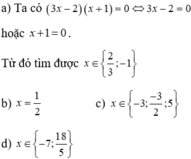Giải các phương trình sau:
a) 3 x − 2 x + 1 = 0 ; b) x 2 + 2 2 x − 1 = 0 ;
c) x + 3 2 x + 3 x − 5 = 0 ; d) x + 7 x + 6 2 − 4 x 3 = 0
Hãy nhập câu hỏi của bạn vào đây, nếu là tài khoản VIP, bạn sẽ được ưu tiên trả lời.



a) Ta có: \(\left|x^2-x+2\right|-3x-7=0\)
\(\Leftrightarrow\left|x^2-x+2\right|=3x+7\)
\(\Leftrightarrow x^2-x+2=3x+7\)(Vì \(x^2-x+2>0\forall x\))
\(\Leftrightarrow x^2-x+2-3x-7=0\)
\(\Leftrightarrow x^2-4x-5=0\)
\(\Leftrightarrow x^2-5x+x-5=0\)
\(\Leftrightarrow x\left(x-5\right)+\left(x-5\right)=0\)
\(\Leftrightarrow\left(x-5\right)\left(x+1\right)=0\)
\(\Leftrightarrow\left[{}\begin{matrix}x-5=0\\x+1=0\end{matrix}\right.\Leftrightarrow\left[{}\begin{matrix}x=5\\x=-1\end{matrix}\right.\)
Vậy: S={5;-1}
bạn giải giúp mình câu b nữa với
mai mình phải nộp bài rồi!!!![]()

a) \(\dfrac{2}{3}x + 1\dfrac{1}{2} = 0\)
\(\dfrac{2}{3}x + \dfrac{3}{2} = 0\)
\(\dfrac{2}{3}x = 0 - \dfrac{3}{2}\) (quy tắc chuyển vế)
\(\dfrac{2}{3}x = \dfrac{{ - 3}}{2}\)
\(x = \dfrac{{ - 3}}{2}:\dfrac{2}{3}\) (quy tắc chia cho một số)
\(x = \dfrac{{ - 9}}{4}\)
Vậy phương trình có nghiệm \(x = \dfrac{{ - 9}}{4}\).
b) \(2\dfrac{1}{2} - 0,75x = 0\)
\(\dfrac{5}{2} - 0,75x = 0\)
\( - 0,75x = 0 - \dfrac{5}{2}\) (quy tắc chuyển vế)
\( - 0,75x = - \dfrac{5}{2}\)
\(x = \left( { - \dfrac{5}{2}} \right):\left( { - 0,75} \right)\) (quy tắc chia cho một số)
\(x = \dfrac{{10}}{3}\)
Vậy phương trình có nghiệm \(x = \dfrac{{10}}{3}\).

a: \(\Leftrightarrow\left[{}\begin{matrix}2x-3=0\\2x+3=1\end{matrix}\right.\Leftrightarrow x=\dfrac{3}{2}\)
\(a,ĐK:x\ge\dfrac{3}{2}\\ PT\Leftrightarrow\sqrt{2x-3}\left(\sqrt{2x+3}-1\right)=0\\ \Leftrightarrow\left[{}\begin{matrix}2x-3=0\\\sqrt{2x+3}=1\end{matrix}\right.\Leftrightarrow\left[{}\begin{matrix}x=\dfrac{3}{2}\left(tm\right)\\x=-1\left(ktm\right)\end{matrix}\right.\Leftrightarrow x=\dfrac{3}{2}\)
\(b,ĐK:x\ge1\\ PT\Leftrightarrow\sqrt{x-1}\left(\sqrt{x+1}-1\right)=0\\ \Leftrightarrow\left[{}\begin{matrix}x-1=0\\x+1=1\end{matrix}\right.\Leftrightarrow\left[{}\begin{matrix}x=1\left(tm\right)\\x=0\left(ktm\right)\end{matrix}\right.\Leftrightarrow x=1\)

a, \(\dfrac{1}{2}\sqrt{x-5}-\sqrt{4x-20+3}=0\left(dkxd:x\ge5\right)\)
\(< =>\dfrac{\sqrt{x-5}}{2}=\sqrt{4x-17}\)
\(< =>\dfrac{x-5}{4}=4x-17\)
\(< =>x-5=16x-68\)
\(< =>15x=68-5=63\)
\(< =>x=\dfrac{63}{15}=\dfrac{21}{5}\)(ktm)
b, \(\sqrt{2x+1}-2\sqrt{x}+1=0\left(dkxd:x\ge0\right)\)
\(< =>\sqrt{2x+1}+1=2\sqrt{x}\)
\(< =>2x+1+1+2\sqrt{2x+1}=4x\)
\(< =>2x-2\sqrt{2x+1}-2=0\)
\(< =>2x+1-2\sqrt{2x+1}+1-4=0\)
\(< =>\left(\sqrt{2x+1}-1\right)^2=4\)
\(< =>\left\{{}\begin{matrix}\sqrt{2x+1}-1=2\\\sqrt{2x+1}-1=-2\end{matrix}\right.\)
\(< =>\left\{{}\begin{matrix}\sqrt{2x+1}=3\\\sqrt{2x+1}=-1\left(loai\right)\end{matrix}\right.\)
\(< =>2x+1=9< =>2x=8< =>x=4\)(tmdk)

a) \(5x - 30 = 0\)
\(5x = 0 + 30\)
\(5x = 30\)
\(x = 30:5\)
\(x = 6\)
Vậy phương trình có nghiệm \(x = 6\).
b) \(4 - 3x = 11\)
\( - 3x = 11 - 4\)
\( - 3x = 7\)
\(x = \left( { 7} \right):\left( { - 3} \right)\)
\(x = \dfrac{-7}{3}\)
Vậy phương trình có nghiệm \(x = \dfrac{7}{3}\).
c) \(3x + x + 20 = 0\)
\(4x + 20 = 0\)
\(4x = 0 - 20\)
\(4x = - 20\)
\(x = \left( { - 20} \right):4\)
\(x = - 5\)
Vậy phương trình có nghiệm \(x = - 5\).
d) \(\dfrac{1}{3}x + \dfrac{1}{2} = x + 2\)
\(\dfrac{1}{3}x - x = 2 - \dfrac{1}{2}\)
\(\dfrac{{ - 2}}{3}x = \dfrac{3}{2}\)
\(x = \dfrac{3}{2}:\left( {\dfrac{{ - 2}}{3}} \right)\)
\(x = \dfrac{{ - 9}}{4}\)
Vậy phương trình có nghiệm \(x = \dfrac{{ - 9}}{4}\).
xem lại câu b nha, tại vì trên là 7 dưới -7

a) \(2{x^2} - 3x + 1 > 0\)
Tam thức \(f\left( x \right) = 2{x^2} - 3x + 1\) có \(a + b + c = 2 - 3 + 1 = 0\) nên hai nghiệm phân biệt \({x_1} = 1\) và \({x_2} = \frac{1}{2}.\)
Mặt khác \(a = 2 > 0,\) do đó ta có bảng xét dấu sau:

Tập nghiệm của bất phương trình là: \(S= \left( { - \infty ;\frac{1}{2}} \right) \cup \left( {1; + \infty } \right).\)
b) \({x^2} + 5x + 4 < 0\)
Tam thức \(f\left( x \right) = {x^2} + 5x + 4\) có \(a - b + c = 1 - 5 + 4 = 0\) nên phương trình có hai nghiệm phân biệt \(x = - 1\) và \(x = - 4.\)
Mặt khác \(a = 1 > 0,\) do đó ta có bảng xét dấu sau:

Tập nghiệm của bất phương trình là: \(S = \left( { - 4; - 1} \right).\)
c) \( - 3{x^2} + 12x - 12 \ge 0\)
Tam thức \(f\left( x \right) = - 3{x^2} + 12x - 12 = - 3\left( {{x^2} - 4x + 4} \right) = - 3{\left( {x - 2} \right)^2} \le 0\)
Do đó
\( - 3{x^2} + 12x - 12 \ge 0 \Leftrightarrow - 3{x^2} + 12x - 12 = 0 \Leftrightarrow - 3{\left( {x - 2} \right)^2} = 0 \Leftrightarrow x = 2.\)
Tập nghiệm của bất phương trình là: \(S = \left( { 2} \right).\)
d) \(2{x^2} + 2x + 1 < 0.\)
Tam thức \(f\left( x \right) = 2{x^2} + 2x + 1\) có \(\Delta = - 1 < 0,\) hệ số \(a = 2 > 0\) nên \(f\left( x \right)\) luôn dướng với mọi \(x,\) tức là \(2{x^2} + 2x + 1 > 0\) với mọi \(x \in \mathbb{R}.\)
\( \Rightarrow \) bất phương trình vô nghiệm

2:
\(A=\dfrac{x_2-1+x_1-1}{x_1x_2-\left(x_1+x_2\right)+1}\)
\(=\dfrac{3-2}{-7-3+1}=\dfrac{1}{-9}=\dfrac{-1}{9}\)
B=(x1+x2)^2-2x1x2
=3^2-2*(-7)
=9+14=23
C=căn (x1+x2)^2-4x1x2
=căn 3^2-4*(-7)=căn 9+28=căn 27
D=(x1^2+x2^2)^2-2(x1x2)^2
=23^2-2*(-7)^2
=23^2-2*49=431
D=9x1x2+3(x1^2+x2^2)+x1x2
=10x1x2+3*23
=69+10*(-7)=-1

a) \(\cot x = 1\; \Leftrightarrow \cot x = \cot \frac{\pi }{4}\;\;\; \Leftrightarrow x = \frac{\pi }{4} + k\pi \;\left( {k \in \mathbb{Z}} \right)\)
b) \(\sqrt 3 \cot x + 1 = 0\;\;\; \Leftrightarrow \sqrt 3 \cot x = - 1\; \Leftrightarrow \cot x = - \frac{{\sqrt 3 }}{3}\;\; \Leftrightarrow \cot x = \cot \left( { - \frac{\pi }{3}} \right)\)
\( \Leftrightarrow x = - \frac{\pi }{3} + k\pi \;\left( {k \in \mathbb{Z}} \right)\)

\(a,\\ \Leftrightarrow3x-x=10-6\\ \Leftrightarrow2x=4\\ \Leftrightarrow x=2\\ b,\\ \Leftrightarrow\left(x-2\right)\left(x+1\right)=0\\ \Leftrightarrow\left[{}\begin{matrix}x-2=0\\x+1=0\end{matrix}\right.\\ \Leftrightarrow\left[{}\begin{matrix}x=2\\x=-1\end{matrix}\right.\)
\(a,\Leftrightarrow3x-x=10-6\\ \Leftrightarrow2x=4\\ \Leftrightarrow x=\dfrac{4}{2}=2\)
Vậy phương trình có tập nghiệm S = \(\left\{2\right\}\)
\(b,\Leftrightarrow\left(x+1\right)\left(x-2\right)=0\\ \Leftrightarrow x+1=0\) hoặc \(\Leftrightarrow x-2=0\)
\(\Leftrightarrow x=-1\) \(\Leftrightarrow x=2\)
Vậy phương trình có tập nghiệm S = \(\left\{-1;2\right\}\)